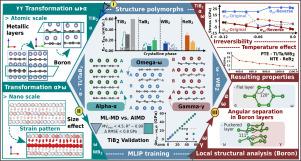基于机器学习势分子动力学的二硼化物剪切激活相变研究
IF 9.3
1区 材料科学
Q1 MATERIALS SCIENCE, MULTIDISCIPLINARY
引用次数: 0
摘要
过渡金属二硼化物(TMB2:s)的层状特征-具有代表不同金属亚晶格堆叠的三种结构多晶态-唤起了通过机械剪切应变激活相变塑性的可能性。这对于克服TMB2: 5最严重的限制:它们的脆性是至关重要的。为了了解α, ω和γ多晶在原子尺度上的有限温度力学响应,我们训练了TMB2:s, TM=(Ti, Ta, W, Re)的机器学习原子间势(MLIPs)。对从头算数据集的验证支持MLIPs预测结构和弹性特性,以及剪切引起的滑移和相变的能力。纳米级分子动力学模拟(>;104原子;≈53nm3)允许评估单晶TMB2:s的理论剪切强度及其从300到1200 K的温度演变。通过角度和键序Steinhardt参数描述子进行的定量结构分析表明(0001)[1¯21¯0]和(0001)[101¯0]剪切激活了TiB2、TaB2和WB2的亚稳相和优选相之间的(能量)转变。这些转变可以通过沿[0001]轴的额外拉伸或压缩应变来促进。ReB2的优选相表现为负热膨胀和前所未有的剪切诱导塑性机制:金属/硼层相互渗透和均匀的晶格旋转。本文章由计算机程序翻译,如有差异,请以英文原文为准。


Shear-activated phase transformations of diborides via machine-learning potential molecular dynamics
The layered character of transition metal diborides (TMB2:s)—with three structure polymorphs representing different stackings of the metallic sublattice—evokes the possibility of activating phase-transformation plasticity via mechanical shear strain. This is critical to overcome the most severe limitation of TMB2:s: their brittleness. To understand finite-temperature mechanical response of the , , and polymorphs at the atomic scale, we train machine-learning interatomic potentials (MLIPs) for TMB:s, TM (Ti, Ta, W, Re). Validation against ab initio data set supports the MLIPs’ capability to predict structural and elastic properties, as well as shear-induced slipping and phase transformations. Nanoscale molecular dynamics simulations ( atoms; ) allow evaluating theoretical shear strengths attainable in single-crystal TMB:s and their temperature evolution from 300 up to 1200 K. Quantitative structural analysis via angular and bond-order Steinhardt parameter descriptors shows that and shearing activates transformations between the (energetically) metastable and the preferred phase of TiB, TaB, and WB. These transformations can be promoted by additional tensile or compressive strain along the [0001] axis. The preferred phase of ReB shows negative thermal expansion and an unprecedented shear-induced plasticity mechanism: metallic/boron layer interpenetration and uniform lattice rotation.
求助全文
通过发布文献求助,成功后即可免费获取论文全文。
去求助
来源期刊

Acta Materialia
工程技术-材料科学:综合
CiteScore
16.10
自引率
8.50%
发文量
801
审稿时长
53 days
期刊介绍:
Acta Materialia serves as a platform for publishing full-length, original papers and commissioned overviews that contribute to a profound understanding of the correlation between the processing, structure, and properties of inorganic materials. The journal seeks papers with high impact potential or those that significantly propel the field forward. The scope includes the atomic and molecular arrangements, chemical and electronic structures, and microstructure of materials, focusing on their mechanical or functional behavior across all length scales, including nanostructures.
 求助内容:
求助内容: 应助结果提醒方式:
应助结果提醒方式:


